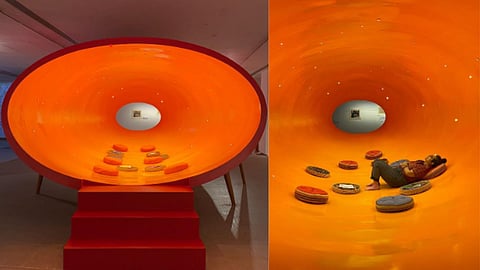
- HOMEGROWN WORLD
- #HGCREATORS
- #HGEXPLORE
- #HGVOICES
- #HGSHOP
- CAREERS
- ABOUT US
- CONTACT US

In the year 2018, a unique work at the intersection of urbanism and architecture was showcased at MACBA Barcelona as a part of the exhibition In The Open and In Stealth. It was an interactive installation art, titled Belly of the Strange, by renowned Mumbai urbanists Rupali Gupte and Prasad Shetty. Both of them hail from backgrounds in writing, architecture, urban design, and town planning. With a career spanning more than fifteen years, they have been involved in creating works that treat Mumbai and cities around the globe as an experimental ground to survey conditions of infrastructure, mobility, social history, and testimonies of everyday experience in the civic milieu.
Belly of the Strange was a space brimming with transactional capabilities, that had been designed to house a treasure trove of books that whisk us away to realms of wonder. But what exactly were these transactional capacities? They represented the inherent abilities of urban forms to accommodate and encourage a multitude of activities. Beyond that, they fostered kinship, security, and care, among other vital aspects. The idea was to create 'transactional objects' that tap not only into functionality but also drew upon the realm of imagination.
In the case of Belly of the Strange, this extraordinary transactional object enabled the audience to gather together and immerse themselves in the pleasure of reading. It cleverly drew upon a medley of associations tied to the peculiarly familiar - a cave, a fruit, a vegetable, or perhaps a grand belly. Just like one of the books within its library playfully asked, it beckoned the inner child within all those who attended the exhibition to ponder, "What might I be?" In a world dominated by rigidly masculine architectural structures, this pudgy belly, evoking feminine forms, seemed to organically sprout within the gallery space. As the attendees stepped into its pulpy interior, a tangible connection was forged with the imaginary realms that books are so beautifully capable of. The soft, yet tactile, interior cradled the books and embraced the reader, transporting them to captivating and vivid destinations.
After its initial success at MACBA, Spain, the installation art’s second version was showcased at the Dhaka Art Summit (2023). At MACBA, the Belly was a large bulbous fruit, softening the architectural space of a modern museum whereas at Dhaka, it was made out of bamboo and paper mache, conjuring a bestial, carnivalesque space.
Now, Belly of the Strange has returned with its third iteration at the famous Kiran Nadar Museum of Art in Delhi as a part of the exhibition titled Very Small Things, which opened today. The mesmerizing installation has now merged as colossal creation, resembling an otherworldly creature or an oversized plaything. This deliberate manipulation of scale serves to bewilder and beguile. Visitors find themselves grappling with the question: Is it a mammoth toy that has sprouted to excessive proportions? Or perhaps a cozy library nestled within the gallery, concealing a universe of possibilities? The enigmatic allure of this expansive entity also draws parallels to distant galaxies, adding to the intrigue.
Once you venture inside this behemoth, its whale-like interior envelops you in a captivating warmth. Illuminated by a gentle, inviting glow, it beckons you to partake in a mesmerizing ritual: the sharing and listening of peculiar, marvelous tales hailing from diverse corners of the globe. These stories have shaped the imaginations of countless children, transcending borders and connecting cultures. Within the Belly of the Strange, multifaceted narratives unfold, sparking wonder and fostering a sense of shared humanity.
So what are you waiting for? Attend the exhibition today to step into a labyrinth that connects you to your inner child and enables you to participate in intergenerational dialogues
Follow Kiran Nadar Museum of Art here.
